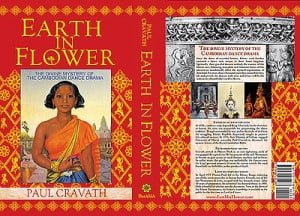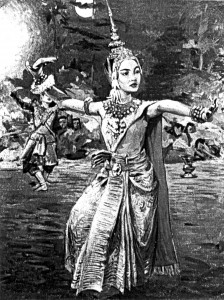Earth in Flower Book Review by Theater Research International
© 2009 Theatre Research International (Cambridge Journals),
34.2 doi:1O.1017IS0307883309004738
Reviewed by Eileen Blumenthal, Rutgers University
It is a vision of astonishing beauty. Graceful women in glittering costumes form a legato flow of anatomy-defying curves and angles. Tied to royalty and central to religious rituals, Cambodia’s traditional dance has become an emblem of the country’s patrimony. It links modern Cambodians to the ancient Angkor Empire, whose sandstone temples are festooned with bas-relief dancers. Earth in Flower Book Review by Theater Research International

Cambodia’s royal dance has long captured the Western imagination, but until recently there was little opportunity to research it. Before 1941, dancers were in the king’s sequestered harem. Western studies of the dance were based on very few viewings or on second-string companies that played for tourists. Paul Cravath’s 1985 doctoral dissertation, Earth in Flower—-only now belatedly published —blew the field open.
He meticulously gleaned information from the scattered studies of Cambodian dance and related subjects. Most importantly, he did first-hand research in Phnom Penh in 1975, examining royal archives, watching rehearsals, and interviewing dancers, teachers and scholars. His research was heroic. Cravath remained in war-torn Phnom Penh, despite daily shelling, until a forced evacuation days before the Khmer Rouge victory. Most of his sources—both written and human—perished during the ensuing nightmare.
His study begins by presenting the ancient Cambodian references and surviving myths that involve dancers. He then incorporates a broader context of South and South-East Asian research and religious studies to derive his thesis: Cambodian dance is fundamentally an embodiment of the life-creating tension and communion between the

feminine and the masculine principle. Cravath proceeds to offer a history of Cambodian dance from ancient times through the twentieth century. And, finally, he documents the dance, cataloguing gestures, movement patterns, costume elements and repertory including many dances no longer performed and gone from living memories. This work is invaluable. And the current presentation, including nearly two hundred black-and-white images, is of art-book quality.
Still, Cravath tends to focus on ideas and oral traditions to support his thesis and to dismiss contravening interpretations and oral traditions. As a result, his argument is overstated and lacks nuance. As the first comprehensive study of the field, his work also inevitably incorporates a few lapses. For example, he does not get quite right the Byzantine relationships between dance and politics in the 1930S and 1940s. But those of us carrying Cambodian dance research forward all are standing on his shoulders. This is an essential volume for anyone interested in South-East Asian performance.
About the reviewer: Eileen Blumenthal
Eileen Blumenthal has a Ph.D. in history of the theater from Yale. She received her M.A. and B.A. degrees in English and American literature from Brown. Her specialties include contemporary experimental theater and traditional Asian theater and theater. She is the author of a book on Joseph Chaikin, numerous theater reviews and articles in the New York Times, the Washington Post, the Wall Street Journal, the Village Voice, American Theater, Asian Theater Journal, Theater, Natural History, and Cultural Survival. She authored a book and many published articles on the performing arts and the contemporary politics of Cambodia, and produced the American tour of theaters from Cambodia in the fall of 1990.
Blumenthal has served as a consultant for public television performing-arts projects, university theater/theater programs, and the National Endowment for the Arts. Her photographs have appeared in the New York Times, the Los Angeles Times, Dance Magazine, Natural History, Cultural Survival, and the Village Voice. Her awards include a Woodrow Wilson Fellowship, a Kent (Danforth) Fellowship, a Guggenheim Fellowship, the George Jean Nathan Award for Dramatic Criticism, a National Endowment for the Humanities Fellowship for University Teachers, and a Rockefeller Foundation Bellagio Residency. At Rutgers University, Mason Gross Theater of the Arts, she has taught history of theater, theater criticism, introduction to graduate study in theater, and modern experimental theater.
